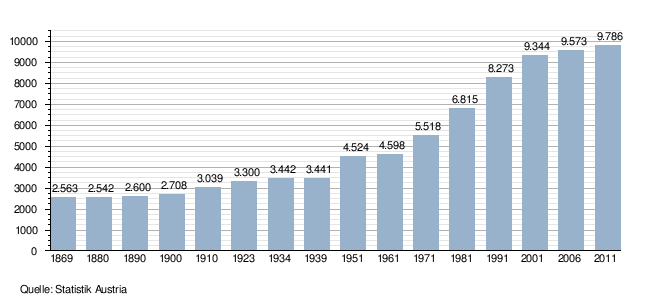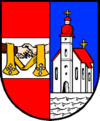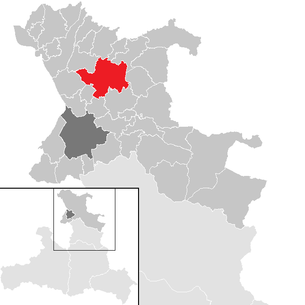Seekirchen am Wallersee
|
Borough Seekirchen am Wallersee
|
||
|---|---|---|
| coat of arms | Austria map | |
|
|
||
| Basic data | ||
| Country: | Austria | |
| State : | Salzburg | |
| Political District : | Salzburg area | |
| License plate : | SL | |
| Surface: | 50.3 km² | |
| Coordinates : | 47 ° 54 ' N , 13 ° 8' E | |
| Height : | 512 m above sea level A. | |
| Residents : | 10,951 (January 1, 2020) | |
| Population density : | 218 inhabitants per km² | |
| Postal code : | 5201 | |
| Area code : | 06212 | |
| Community code : | 5 03 39 | |
| NUTS region | AT323 | |
| Address of the municipal administration: |
Stiftsgasse 1 5201 Seekirchen am Wallersee |
|
| Website: | ||
| politics | ||
| mayor | Konrad Pieringer ( ÖVP ) | |
| Municipal Council : (2019) | ||
| Location of Seekirchen am Wallersee in the Salzburg-Umgebung district | ||
| Source: Municipal data from Statistics Austria | ||
Seekirchen is a town with 10,951 inhabitants (as of January 1, 2020) in Flachgau in the state of Salzburg in Austria . It is located directly on the Wallersee , across from Neumarkt am Wallersee . Seekirchen has been documented for over 1300 years, but has only recently been granted city rights.
geography
Seekirchen am Wallersee is part of the judicial district of Neumarkt near Salzburg . Neighboring communities are Anthering , Elixhausen , Eugendorf , Hallwang , Henndorf am Wallersee , Köstendorf , Mattsee , Obertrum am See and Schleedorf .
Community structure
Locations (residents as of January 1, 2020):
- Bayerham (155) including Wallersee-Zell
- Brunn (1032) including Am Pfaffenbühel, Eck, Grub, Haging, Köllersberg and Weinberg
- Fischtaging (239) including Frauentaging, Haberg, Schlacht, Weiland and weekend settlement Fischtaging
- Halberstätten (202) including Bruckermühle, Prossing and Schmiedberg
- Huttich (242) including Gezing, Oberkriechham, Unterkriechham and Wirthenstätten
- Kothgumprechting (142) including fiefdom, Modhalm and Roid
- Kraiham (132) including crimping places
- Mayerlehen (303) including Grünberg, Mitterstatt, Oberhof, Ronach and Wendling
- Mödlham (457) including Obernbichl, Untermödlham and Wolfzagl
- Reed (202)
- Schmieding (105) including Krainbach and Obermödlham
- Blacksmith Cellar (138)
- Schöngumprechting (275) including Bruderstatt, Kothhäuslsiedlung and Kreuzeck
- Seekirchen am Wallersee (3664)
- Seewalchen (1071) including Oberleiten
- Waldprechting (1565) including Gröm and SOS Children's Villages
- Wies (163) including fish farmers, marshals, ruckers and Wies-scattering houses
- Wimm (239) including Am Schreiberg, Hipping and Kühmosen
- Wimmsiedlung (503)
- Zaisberg (122) including Reith and Zaisberg-Streue houses
The community consists of the cadastral communities Marschalln, Mödlham, Seekirchen Land, Seekirchen Markt, Seewalchen and Waldprechting.
history
People have been living in the municipality of Seekirchen for at least 5000 years ( Neolithic ). Seekirchen was first mentioned in a document by St. Rupert (Bishop of Worms) in 696 . At the hermit house he founded there was also a church dedicated to St. Petrus church, first church and marriage church called, from which allegedly the place name Seekirchen emerged through corruption . Seekirchen is the longest continuously inhabited place in Austria. In 1424 the elevation to the market town took place . On July 1, 1974, the independent communities of Seekirchen Markt and Seekirchen Land were merged to form the community of Seekirchen am Wallersee. Seekirchen was granted town charter on St. Rupert's Day (September 24th) in 2000.
coat of arms
Description of the coat of arms : In a split shield on the right in red a silver bar, in which two forearms growing out of the field edges, wrapped in a golden stole, hold hands together. The right arm dressed in brown (man), the left arm naked (woman). On the left, in blue over a naturally colored wave shield base on a silver floor, a silver church with red roofs. Outside, above the upper edge of the shield, next to each other the black years 1424 and 1974.
Population development

politics
The community council has a total of 25 members.
- With the municipal council and mayoral elections in Salzburg in 2004, the municipal council had the following distribution: 11 ÖVP, 5 SPÖ, 4 FDS, 3 LESE and 2 FPÖ
- With the municipal council and mayoral elections in Salzburg in 2009 , the municipal council had the following distribution: 11 ÖVP, 5 FWS, 4 SPÖ, 3 LESE and 2 FPÖ
- With the municipal council and mayoral elections in Salzburg in 2014 , the municipal council had the following distribution: 9 ÖVP, 6 LESE, 4 FPÖ, 3 FWS and 3 SPÖ
- With the municipal council and mayor elections in Salzburg in 2019 , the municipal council has the following distribution: 10 ÖVP, 6 LESE - Initiative Livable Seekirchen, 4 FPÖ, 3 SPÖ and 2 FWS - Free Voters Seekirchen.
- mayor
- 1959–1974–1979 Anton Moser
- 1979–1987 Johann Haberl (ÖVP)
- 1987–2009 Johann Spatzenegger (ÖVP)
- 2009–2019 Monika Schwaiger (ÖVP)
- since 2019 Konrad Pieringer (ÖVP)
economy
Small and medium-sized enterprises shape the economic structure of Seekirchen. Of the approximately 300 companies, more than 90 percent employ fewer than 5 people.
The town center of Seekirchen was able to maintain its trading structure with predominantly small businesses despite the immigration of chain stores.
Over 65 small and medium-sized businesses from trade, craft, gastronomy and service are organized in the Seekirchen City Marketing. The association, financed by the municipality of Seekirchen, the tourism association and traders, has existed since 2004. The main purpose is to revitalize and make the city center more attractive and to organize joint advertising and PR activities. Until 2004, this task was taken over by the advertising association “Kauf in”.
Of the approx. 5000 hectares of the community area, around 4000 hectares are used for agriculture and forestry . 16% of this area (approx. 640 ha) is used for forestry. The remaining 84% are mainly available for grassland use. Of the around 170 cattle-keeping farms, 4,800 dairy cows and around 2,400 young cattle are kept.
Most of the milk produced is processed into Emmental cheese. About 30% of the farms are run as full-time businesses, the remaining 70% as additional and sideline businesses. The ownership structure of the approximately 240 agricultural landowners has hardly changed in the last 70 years.
Culture and sights
- Collegiate monastery and deanery church hl. Peter with the manager's yard in the center of the village
- Filial church hl. Nikolaus and Bischofsgut in Waldprechting
- Filial church hl. Maria Magdalena in Wallersee-Zell
- Blacksmith Chapel
- Seeburg castle with chapel hl. Rupert
- Local history and monastery museum
- Zeller Schlösschen
- Kulturhaus Emailwerk : The Kulturhaus is run by the KunstBox cultural association, a cultural association founded in 2004. The main goals of the KunstBox cultural association are to promote cultural activity in Seekirchen and the region and to create the framework conditions necessary for professional cultural work. The association also offers a program geared towards the main cultural sectors and a wide range of cultural training opportunities. The cultural association KunstBox is a member of the umbrella association Salzburg cultural sites and the IG Kultur Österreich, in the Salzburg provincial cultural advisory board and in the advisory board for cultural initiatives in the Salzburg region.
traffic
- Train: Seekirchen is located directly on the Westbahn and has a train station where both express trains and the S2 line of the Salzburg S-Bahn stop, thereby ensuring a quick connection to the state capital Salzburg . There is a second train station in Zell / Wallersee.
- Bus: There is also a connection to the Trumer Seenland with the Postbus line 131 . A free city bus has been available since December 2017.
education
- Private University of Seeburg Castle
- Seekirchen elementary school
- Mödlham primary school
- NMS Seekirchen
- Seekirchen Adult Education Center
- Seekirchen Federal High School
- Vineyard school in Huttich
Sports
Well known is the football club SV Seekirchen 1945 , which was founded in 1945 and currently plays in the Regionalliga West , the third highest level in Austrian football, and with the brothers Ibertsberger, Thomas Winklhofer and Stefan Lainer even produced four Austrian national football players.
ASKÖ SC Seekirchen 1980 is a fistball club founded in 1980 by Gerhard Strasser, Peter Braunwieser and Manfred Schmidhuber and currently plays in the 2nd Bundesliga. In the youth field, ASKÖ Seekirchen is one of the most successful clubs in Austria with several Austrian championship titles. Lukas Pichelstorfer achieved silver with the U18 national team at the world championships, Andrea Mödlhamer, Veronika Pfund and Lukas Pichelstorfer achieved bronze at the U18 European championships.
Personalities
Sons and Daughters of the Church:
- Franz Braumann (1910-2003), author
- Herbert Pichler (1921–2018), physician and television commentator
- Helma Schimke (1926–2018), architect and mountaineer
- Dieter Kugele (* 1944), judge at the Federal Administrative Court and German legal scholar
- Albert Hartinger (1946–2020), singer and conductor
- Thomas Winklhofer (* 1970), national soccer player and UEFA Cup finalist
- Andreas Ibertsberger (* 1982), national soccer player
- Stefan Lainer (* 1992), national soccer player
- Daniel Huber (* 1993), ski jumper
- Stefan Huber (* 1994), ski jumper
People related to the municipality:
- Thomas Bernhard (1931–1989), writer, spent part of his childhood (1935–1937) with his grandparents Anna and Johannes Freumbichler in Seekirchen
- Robert Ibertsberger (* 1977), national soccer player; grew up in Seekirchen
- Markus Inderst (* 1974), journalist and book author; lived in Seekirchen
- Wend von Kalnein (1914–2007), art historian , honorary professor at the University of Salzburg and writer; lived in Seekirchen
- Manfred Pamminger (* 1977), soccer player; grew up in Seekirchen
- Clemens Sedmak (* 1971), theologian and philosophy professor; lives in Seekirchen
Web links
Individual evidence
- 50339 - Seekirchen am Wallersee. Community data, Statistics Austria .
- Seekirchen am Wallersee . In: Salzburger Nachrichten : Salzburgwiki .
- ↑ Statistics Austria: Population on January 1st, 2020 by locality (area status on January 1st, 2020) , ( CSV )
- ↑ Werner Rainer: Marcus Sitticus . The government of the Prince Archbishop according to the chronicle of Johannes Stainhauser, at the same time: Communications of the Society for Salzburg Regional Studies, 29th supplementary volume, Salzburg 2012, ISBN 978-3-200-02639-1 . P. 165.
- ↑ http://www.seekirchen.at/Gemeindevertretungswahl_2004
- ↑ http://www.seekirchen.at/Gemeindevertretungswahl_2009_1
- ↑ http://www.seekirchen.at/Gemeindevertretungswahl_2014_1
- ↑ https://www.salzburg.gv.at/stat/wahlen/gvw/index2019.html#erg.105.0.0.2
- ^ Anton Moser . In: Salzburger Nachrichten : Salzburgwiki .
- ↑ Johann Haberl . In: Salzburger Nachrichten : Salzburgwiki .
- ↑ Johann Spatzenegger . In: Salzburger Nachrichten : Salzburgwiki .
- ↑ Monika Schwaiger . In: Salzburger Nachrichten : Salzburgwiki .
- ↑ https://www.salzburg.gv.at/stat/wahlen/bmw/index2019.html#erg.105.1
- ↑ a b c d e f Dehio Salzburg 1986 , Seekirchen am Wallersee, pages 397 to 404








